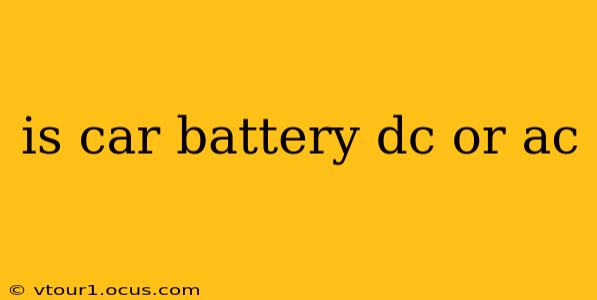Car batteries are DC, or direct current, power sources. This is a fundamental aspect of automotive electrical systems, and understanding the difference between DC and AC is crucial to comprehending how your car's electrical components function. Let's delve into the specifics.
What is the Difference Between DC and AC?
Before we answer the main question definitively, it's important to understand the difference between direct current (DC) and alternating current (AC).
-
Direct Current (DC): In a DC circuit, the electrons flow consistently in one direction. Think of a battery – the positive and negative terminals maintain a constant polarity, resulting in a unidirectional flow of electrons. This is the type of power supplied by batteries, including car batteries.
-
Alternating Current (AC): In an AC circuit, the direction of electron flow periodically reverses. This creates a cyclical pattern of current, oscillating back and forth. This is the type of electricity that comes from power outlets in your home.
Why Do Cars Use DC Power?
Cars utilize DC power primarily because of the way batteries function. Lead-acid batteries, the most common type in automobiles, inherently produce direct current. This DC power is then used to operate various components within the vehicle. Converting this DC power to AC would introduce unnecessary complexity and inefficiency.
Furthermore, many automotive components, such as lights, motors, and sensors, are designed to operate directly on DC power. Adapting these components for AC power would require additional and costly conversion systems.
What About the Alternator? Doesn't That Produce AC?
Yes, the alternator, which charges the car battery, actually generates alternating current (AC). However, the alternator includes a rectifier that immediately converts this AC power into DC, which is then used to charge the battery and power the vehicle's electrical system. This ensures a consistent DC supply to all components.
How is DC Power Distributed in a Car?
The DC power from the battery is distributed throughout the car using a complex network of wires and fuses. This network ensures that each component receives the appropriate voltage and current. The system is designed for safety and efficiency, minimizing the risk of short circuits and power surges.
Can I Use AC Power in My Car?
No, you should never attempt to directly connect AC power to your car's electrical system. Doing so would likely damage the components and could be extremely dangerous. The electrical system is designed specifically for DC, and the introduction of AC power can cause significant problems.
What are the Benefits of Using DC in Cars?
The use of DC power in cars offers several key advantages:
- Simplicity: DC systems are generally simpler and less expensive to design and maintain compared to AC systems.
- Efficiency: DC power is more efficient for many automotive applications, resulting in less energy loss.
- Compatibility: Most automotive components are designed to work optimally with DC power.
In conclusion, car batteries are definitively DC power sources, and this choice reflects the practical and efficiency-driven design of automotive electrical systems. Understanding this fundamental distinction is key to comprehending the workings of your car.
